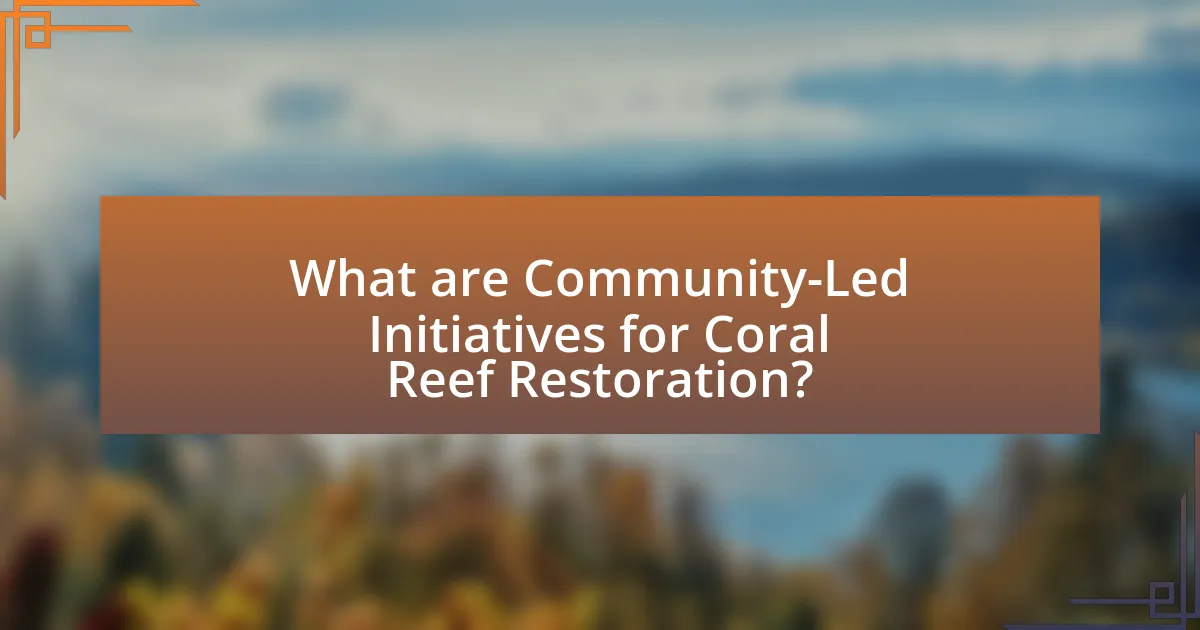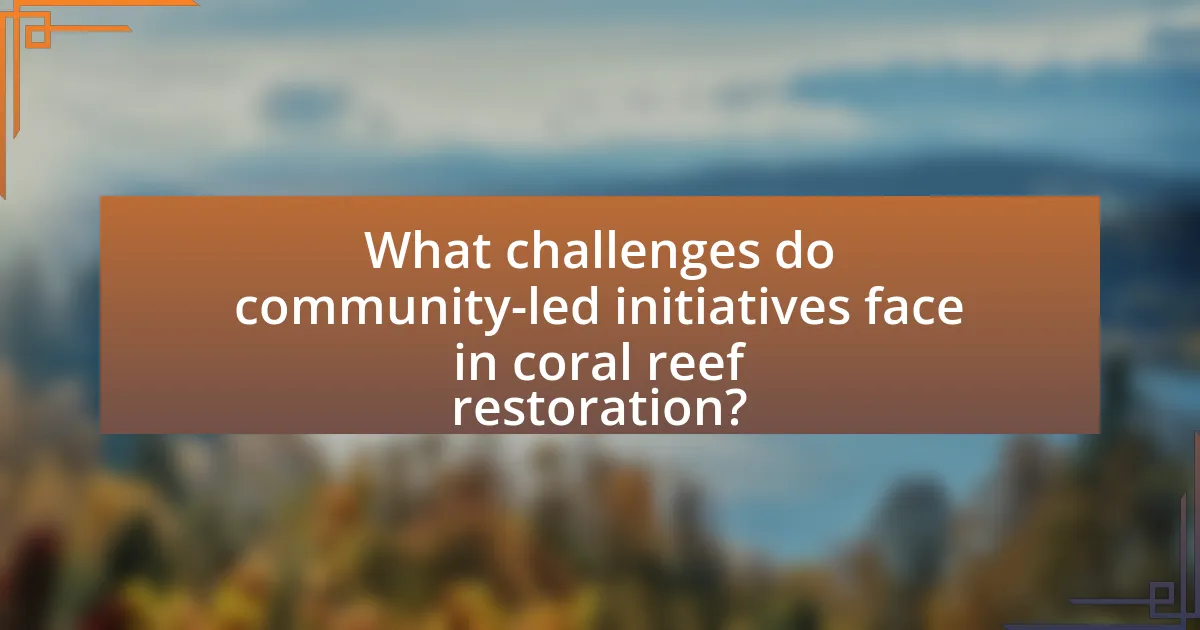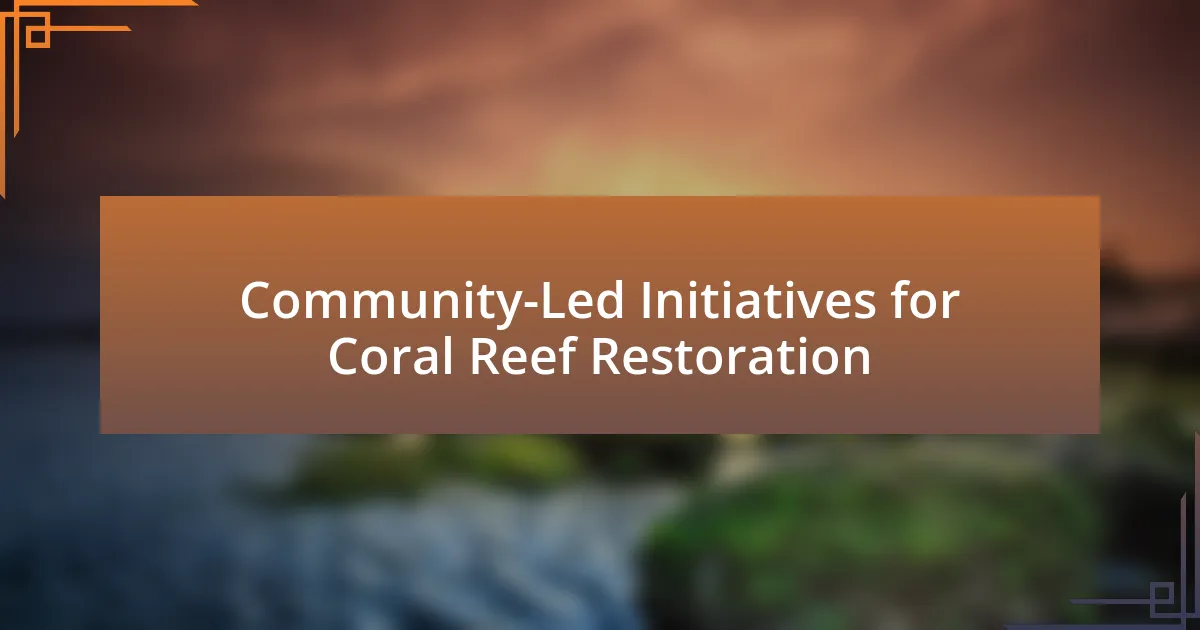Community-led initiatives for coral reef restoration are collaborative efforts where local populations engage in the conservation and rehabilitation of coral ecosystems. These initiatives encompass activities such as coral gardening, reef health monitoring, and community education, which enhance biodiversity and promote sustainable livelihoods. Successful examples from regions like the Philippines and Australia demonstrate the ecological benefits of local involvement, including increased coral cover and improved fish populations. However, challenges such as limited funding, lack of technical expertise, and social barriers can hinder these efforts. Effective strategies for overcoming these obstacles include education, collaboration with NGOs, and adaptive management practices, which empower communities to replicate successful restoration methods tailored to their specific contexts.

What are Community-Led Initiatives for Coral Reef Restoration?
Community-led initiatives for coral reef restoration are collaborative efforts where local communities actively engage in the conservation and rehabilitation of coral ecosystems. These initiatives often involve activities such as coral gardening, where community members cultivate and transplant coral fragments to degraded areas, and monitoring reef health through citizen science programs. Evidence shows that such initiatives can enhance biodiversity, improve reef resilience, and foster sustainable livelihoods, as demonstrated by successful projects in places like the Philippines and Australia, where local involvement has led to significant ecological recovery and community empowerment.
How do these initiatives engage local communities?
Community-led initiatives for coral reef restoration engage local communities by involving them in the planning, implementation, and monitoring processes of restoration activities. These initiatives often include training programs that educate community members about coral ecosystems, fostering a sense of ownership and responsibility towards their local marine environment. For example, the Coral Triangle Initiative has successfully mobilized local fishers and community members to participate in reef monitoring and restoration efforts, leading to improved biodiversity and sustainable fishing practices. This active participation not only enhances the effectiveness of restoration efforts but also strengthens community ties and promotes environmental stewardship.
What roles do community members play in coral reef restoration?
Community members play crucial roles in coral reef restoration by actively participating in conservation efforts, monitoring reef health, and implementing restoration projects. Their involvement often includes organizing clean-up activities, educating others about the importance of coral ecosystems, and advocating for sustainable practices. Research indicates that community-led initiatives can significantly enhance the effectiveness of restoration efforts, as local knowledge and commitment lead to better management of marine resources. For instance, a study published in the journal “Marine Policy” highlights that communities engaged in reef restoration saw a 30% increase in coral cover over five years, demonstrating the tangible impact of their contributions.
How does community involvement enhance the effectiveness of restoration efforts?
Community involvement enhances the effectiveness of restoration efforts by fostering local stewardship and ensuring that initiatives are culturally relevant and supported by the community. Engaged communities are more likely to participate actively in restoration activities, leading to increased labor and resources dedicated to the project. For example, studies have shown that when local communities are involved in coral reef restoration, such as through the establishment of marine protected areas, there is a significant increase in biodiversity and resilience of the ecosystem. This is evidenced by research conducted by the World Resources Institute, which found that community-managed reefs showed a 30% higher recovery rate compared to those managed solely by external organizations. Thus, community involvement not only boosts participation but also enhances ecological outcomes through localized knowledge and commitment.
Why are community-led initiatives important for coral reef ecosystems?
Community-led initiatives are crucial for coral reef ecosystems because they empower local populations to actively participate in conservation efforts, leading to more effective and sustainable management of these ecosystems. Research indicates that when communities are involved, there is a higher likelihood of compliance with conservation measures, as local stakeholders have a vested interest in the health of their environment. For example, a study published in the journal “Marine Policy” found that community-managed marine areas in the Philippines showed significantly improved fish biomass and biodiversity compared to areas without local management. This demonstrates that community engagement not only fosters stewardship but also enhances the resilience of coral reefs against threats such as climate change and overfishing.
What ecological benefits do these initiatives provide?
Community-led initiatives for coral reef restoration provide significant ecological benefits, including enhanced biodiversity and improved ecosystem resilience. These initiatives often involve local communities in the restoration process, which leads to the successful re-establishment of coral populations and associated marine life. For instance, studies have shown that restored coral reefs can support up to 50% more fish species compared to degraded reefs, thereby increasing overall marine biodiversity. Additionally, healthy coral reefs act as natural barriers against coastal erosion and provide essential habitats for various marine organisms, contributing to the stability of marine ecosystems.
How do they contribute to biodiversity conservation?
Community-led initiatives for coral reef restoration contribute to biodiversity conservation by actively engaging local populations in the protection and rehabilitation of coral ecosystems. These initiatives often involve the restoration of coral habitats, which supports a diverse range of marine species, thereby enhancing overall biodiversity. For instance, studies have shown that restored coral reefs can increase fish populations by up to 50%, providing critical habitats for various marine organisms. Additionally, community involvement fosters sustainable practices that reduce overfishing and pollution, further protecting the delicate balance of marine ecosystems.

What challenges do community-led initiatives face in coral reef restoration?
Community-led initiatives in coral reef restoration face several significant challenges, including limited funding, lack of technical expertise, and insufficient community engagement. Limited funding restricts the ability to implement comprehensive restoration projects, as many initiatives rely on grants or donations that may not be consistently available. Additionally, a lack of technical expertise can hinder the effectiveness of restoration efforts, as community members may not possess the necessary skills or knowledge to carry out complex ecological interventions. Insufficient community engagement can also pose a challenge, as successful restoration often requires the active participation and commitment of local stakeholders, which may be difficult to achieve if there is a lack of awareness or interest in coral reef issues. These challenges collectively impact the sustainability and success of community-led coral reef restoration initiatives.
What are the common obstacles encountered by these initiatives?
Common obstacles encountered by community-led initiatives for coral reef restoration include limited funding, lack of technical expertise, and insufficient community engagement. Limited funding restricts the ability to implement and sustain restoration projects, as many initiatives rely on grants or donations that may not be consistently available. Lack of technical expertise can hinder effective restoration practices, as community members may not possess the necessary skills or knowledge to carry out complex ecological tasks. Insufficient community engagement often leads to a lack of local support and participation, which is crucial for the success of restoration efforts. These challenges are documented in various studies, including the report by the International Union for Conservation of Nature, which highlights funding and community involvement as critical factors influencing the effectiveness of coral restoration initiatives.
How do funding and resource limitations impact restoration efforts?
Funding and resource limitations significantly hinder restoration efforts by restricting the availability of necessary materials, expertise, and manpower. For instance, without adequate financial support, community-led initiatives may struggle to procure essential tools and technologies required for effective coral reef restoration. A study by the National Oceanic and Atmospheric Administration (NOAA) highlights that projects with insufficient funding often face delays or are unable to implement critical restoration techniques, such as coral nurseries or transplantation efforts. Additionally, limited resources can lead to reduced community engagement and training opportunities, further diminishing the capacity for successful restoration outcomes.
What social and cultural barriers affect community participation?
Social and cultural barriers that affect community participation include socioeconomic disparities, cultural norms, and lack of trust in institutions. Socioeconomic disparities can limit access to resources and information, making it difficult for marginalized groups to engage in community initiatives. Cultural norms may dictate participation levels, where certain groups may feel excluded due to traditional beliefs or practices. Additionally, a lack of trust in local authorities or organizations can hinder collaboration, as communities may be skeptical of the intentions behind initiatives. Research indicates that these barriers can significantly reduce the effectiveness of community-led projects, as seen in various studies on environmental conservation efforts.
How can these challenges be overcome?
Community-led initiatives for coral reef restoration can overcome challenges through education, collaboration, and sustainable practices. Education empowers local communities with knowledge about coral ecosystems, fostering stewardship and active participation in restoration efforts. Collaboration among stakeholders, including local governments, NGOs, and scientists, enhances resource sharing and expertise, leading to more effective restoration strategies. Implementing sustainable practices, such as responsible fishing and pollution control, mitigates environmental stressors on coral reefs, ensuring their resilience and recovery. These approaches have been validated by successful case studies, such as the Coral Triangle Initiative, which demonstrates that community engagement significantly improves coral health and biodiversity.
What strategies have proven effective in enhancing community engagement?
Effective strategies for enhancing community engagement in coral reef restoration include participatory decision-making, education and awareness programs, and the establishment of local stewardship groups. Participatory decision-making empowers community members by involving them in the planning and implementation processes, which has been shown to increase ownership and commitment to restoration efforts. Education and awareness programs raise understanding of coral ecosystems and the importance of their preservation, leading to more active participation. Establishing local stewardship groups fosters a sense of responsibility and collective action among community members, as evidenced by successful initiatives in regions like the Caribbean, where local involvement has led to improved coral health and biodiversity.
How can partnerships with NGOs and government agencies support these initiatives?
Partnerships with NGOs and government agencies can significantly enhance community-led initiatives for coral reef restoration by providing essential resources, expertise, and policy support. NGOs often bring specialized knowledge in marine conservation and community engagement, which can help design effective restoration strategies. For instance, organizations like The Nature Conservancy have successfully collaborated with local communities to implement coral restoration projects, demonstrating the effectiveness of such partnerships. Government agencies can facilitate access to funding, regulatory support, and scientific research, ensuring that initiatives align with broader environmental policies. A study by the World Resources Institute highlights that collaborative efforts between local communities and government bodies have led to improved management practices and increased resilience of coral ecosystems.

What successful examples exist of community-led coral reef restoration initiatives?
Successful examples of community-led coral reef restoration initiatives include the Coral Triangle Initiative in Southeast Asia and the Reef Restoration Foundation in Australia. The Coral Triangle Initiative, which involves local communities in Indonesia, Malaysia, and the Philippines, focuses on sustainable fishing practices and habitat restoration, leading to improved biodiversity and fish populations. The Reef Restoration Foundation engages local volunteers in planting coral and monitoring reef health, resulting in increased coral cover and resilience against climate change. Both initiatives demonstrate the effectiveness of community involvement in restoring coral ecosystems, supported by data showing enhanced marine biodiversity and ecosystem services in the areas where these programs are implemented.
What are some notable case studies from around the world?
Notable case studies in community-led initiatives for coral reef restoration include the Coral Triangle Initiative in Southeast Asia, which involves multiple countries collaborating to protect marine biodiversity and restore coral reefs. Another significant example is the Reef Restoration Project in the Bahamas, where local communities engage in coral gardening and transplantation efforts to rehabilitate damaged reefs. Additionally, the Great Barrier Reef Marine Park Authority in Australia has implemented community-based programs that empower local stakeholders to participate in reef monitoring and restoration activities. These case studies demonstrate effective community involvement in coral reef conservation and restoration efforts globally.
How did these initiatives achieve their goals?
Community-led initiatives for coral reef restoration achieved their goals through active local engagement, education, and sustainable practices. By involving local communities in the restoration process, these initiatives fostered a sense of ownership and responsibility towards coral ecosystems. For instance, programs that trained community members in coral gardening techniques resulted in increased coral cover and biodiversity, as evidenced by a study conducted in the Caribbean, which reported a 30% increase in coral cover over five years. Additionally, educational workshops raised awareness about the importance of coral reefs, leading to better conservation practices among local fishers and tourism operators. These combined efforts not only restored coral habitats but also enhanced community livelihoods, demonstrating the effectiveness of collaborative approaches in achieving ecological and social goals.
What lessons can be learned from these successful projects?
Successful community-led initiatives for coral reef restoration demonstrate the importance of local engagement and collaboration. These projects show that involving local communities in decision-making and implementation leads to more sustainable outcomes, as community members possess valuable knowledge about their ecosystems. For instance, the Coral Triangle Initiative, which involves multiple Southeast Asian countries, highlights how shared responsibility and local stewardship can enhance conservation efforts. Additionally, successful projects often emphasize the need for education and capacity building, ensuring that community members are equipped with the skills necessary for effective restoration. This approach has been validated by studies indicating that projects with strong community involvement have higher survival rates for restored coral species.
What best practices can be derived from successful initiatives?
Best practices derived from successful community-led initiatives for coral reef restoration include active community engagement, adaptive management strategies, and collaboration with local stakeholders. Active community engagement fosters ownership and commitment, as seen in the Coral Triangle Initiative, where local communities participated in decision-making processes, leading to increased conservation efforts. Adaptive management strategies allow for flexibility and responsiveness to changing environmental conditions, exemplified by the Great Barrier Reef Marine Park Authority, which adjusts its management practices based on ongoing research and monitoring. Collaboration with local stakeholders, including fishermen and tourism operators, enhances resource sharing and knowledge exchange, as demonstrated by the successful partnerships in the Caribbean, which have led to improved reef health and resilience.
How can communities replicate successful strategies in their own contexts?
Communities can replicate successful strategies in their own contexts by adapting proven methods to local environmental, social, and economic conditions. For instance, a community that successfully restored coral reefs may implement similar techniques, such as coral gardening or community monitoring, while considering local species, climate conditions, and cultural practices. Research shows that localized adaptations of successful strategies, like those documented in the “Coral Triangle Initiative,” enhance effectiveness and sustainability, as they align with specific community needs and ecological contexts.
What tools and resources are available to support these efforts?
Tools and resources available to support community-led initiatives for coral reef restoration include coral nurseries, marine protected areas, and educational programs. Coral nurseries provide a controlled environment for growing coral fragments, which can later be transplanted to damaged reefs, enhancing their recovery. Marine protected areas offer legal frameworks that safeguard coral ecosystems from harmful activities, allowing natural regeneration. Educational programs equip local communities with knowledge about coral ecosystems and restoration techniques, fostering active participation and stewardship. These resources collectively empower communities to effectively engage in coral reef restoration efforts.
What practical steps can communities take to initiate their own coral reef restoration projects?
Communities can initiate their own coral reef restoration projects by forming local conservation groups, conducting assessments of the reef’s health, and collaborating with marine scientists for guidance. Establishing a community group allows for organized efforts and resource pooling, while health assessments help identify specific areas needing restoration. Collaboration with marine scientists ensures that restoration techniques, such as coral gardening or artificial reef installation, are scientifically sound and effective. For instance, the Coral Triangle Initiative has successfully engaged local communities in restoration efforts, demonstrating that community involvement can lead to significant ecological improvements.
